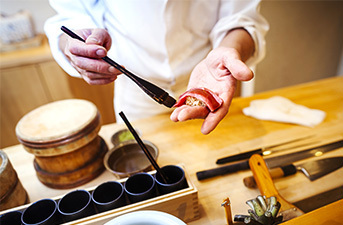Vegetarian Kaiseki Restaurants(14)
Dates
Today
Tomorrow
Clear
Filters
Cuisine
Kaiseki
No Result Found.
Dietary Restrictions
Vegetarian
No Result Found.
Price range
No Result Found.
Clear
Apply
KYOTO
Seiwasou
The beautiful Edo period architecture of Seiwasou draws many guests to its gardens, and the traditional Kyoto-style kaiseki cuisine keeps them at the table.
Lunch: ¥7,000-45,000
Dinner: ¥15,000-45,000
TOKYO
Seisoka
Be rejuvenated by the peaceful atmosphere while dining at the most outstanding traditional kaiseki restaurant.
Lunch: ¥7,700-16,500
Dinner: ¥27,500-38,500
KYOTO
Honke Tankuma Honten
Explore the various seasons in Japan through Kyoto-style kappo cuisine at Honke Tankuma Honten, where they craf special course meals for everyone.
Dinner: ¥22,000-55,000
TOKYO
Tokyo Shiba Toufuya Ukai
A contender for most picturesque restaurant in Japan — this historic compound house plays host to the finest tofu-based dining.
Lunch: ¥8,800-22,000
Dinner: ¥14,000-22,000
HYOGO
Sakabayashi
Traditional Japanese food and sake combine to create meals bursting with fresh local flavors at this sake brewery in Kobe.
Lunch: ¥5,000-30,000
Dinner: ¥5,000-30,000
TOKYO
Miyuki (Hotel Chinzanso Tokyo)
The most exquisite dining experience paired with the most exquisite cuisine. Within Tokyo’s natural Sea of Clouds, Miyuki offers a variety of Japanese course meals, from kaiseki to sushi to teppanyaki.
Lunch: ¥5,000-10,000
Dinner: ¥10,000-15,000
KYOTO
Muromachi Wakuden
Witness your meal take shape during each step of the way at this performative kaiseki powerhouse.
Lunch: ¥15,000-20,000
Dinner: ¥20,000-30,000
AICHI
Kaiseki Hachisen
Achieve culinary enlightenment with Japan’s only Michelin-starred Zen priest.
Lunch: ¥15,000-19,999
Dinner: ¥20,000-29,999
OSAKA
Japanese Restaurant Benkay
Offering something to suit the tastes of every member of your group, this fine-dining staple inside the 5-star Hotel Nikko Osaka is a perfect spot for a celebration. Enjoy master-crafted sushi, exquisite kaiseki, and more.
Lunch: ¥5,000-9,999
Dinner: ¥10,000-14,999
TOKYO
Kinsui
Exquisite Japanese cuisine and warm hospitality await at Kinsui, the kaiseki restaurant inside Hotel Chinzanso Tokyo. Indulge in traditional flavors, serene ambiance, and impeccable service.
Lunch: ¥10,000-15,000
Dinner: ¥50,000-60,000
TOKYO
Tsukiji Jisaku
Experience the tranquility and traditional beauty of Tsukiji Jisaku. Established in 1931, this historic establishment features a breathtaking Japanese garden and a secluded space that offers a serene escape from the world.
Lunch: ¥15,000-20,000
Dinner: ¥20,000-30,000
FUKUOKA
Sensui
A taste of the oceans around Fukuoka, with a great selection of alcohol to match.
Lunch: ¥10,000-14,999
Dinner: ¥15,000-19,999
KYOTO
Naruya
New facets to old favorites are exposed through the touch of these expert 2021 Michelin-starred chefs.
Lunch: ¥15,000-19,999
Dinner: ¥20,000-29,999
KYOTO
Shokudou Ogawa
A high-end take on the humble pub — come enjoy Kyoto’s top izakaya.
Dinner: ¥20,000-29,999
Tailor-Made Tours
Can’t find what you’re looking for? We can plan a custom-made food experience or itinerary just for you.
